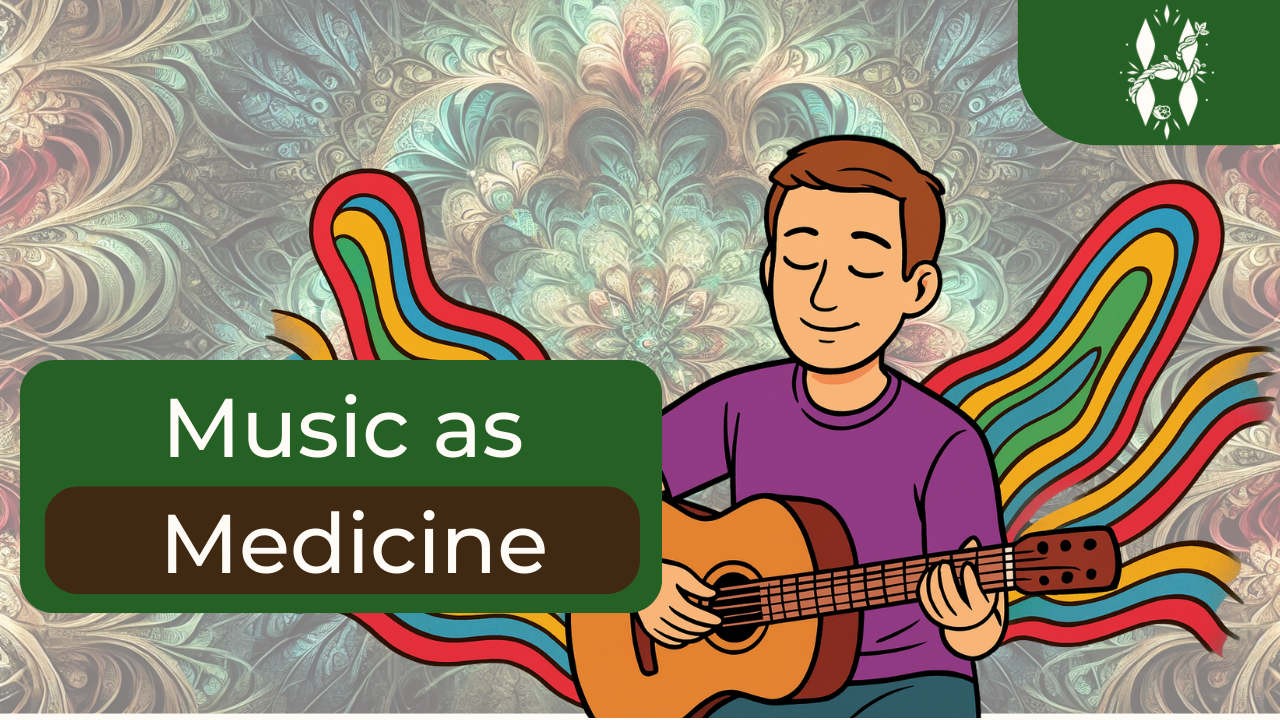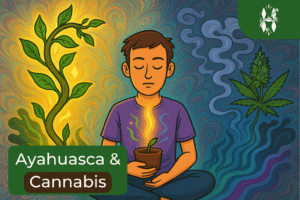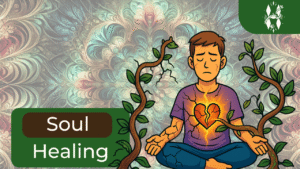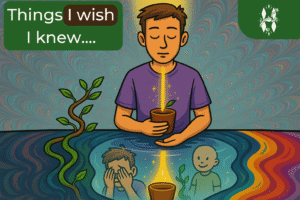When people talk about Ayahuasca, they often speak about visions, purging, or deep realizations. But ask anyone who has sat in ceremony, and they will tell you that one of the most unforgettable aspects is the music. Whether it’s the steady beat of a drum, the call of a flute, or the profound silence between songs, sound shapes the entire experience.
In this article, we’ll explore why music matters in Ayahuasca ceremonies, the traditional and modern instruments used, the difference between Icaros and Rezos, and why silence itself is sometimes the most powerful song of all.
Key Takeaways on Ayahuasca Ceremony Music in 2025
- Music is central to the journey — live instruments and sacred songs (icaros and rezos) help guide emotions, visions, and energy flow.
- Different traditions bring unique sounds — Peruvian ceremonies often focus on icaros, Colombian on rezos and harmonica, while modern retreats may add hand pans or singing bowls.
- Nature itself is part of the music — jungle sounds like insects, frogs, and wind are considered medicine, blending seamlessly with instruments.
- Silence is just as powerful as sound — pauses create space for inner reflection, emotional release, and deeper integration.
- Authenticity matters — live music with intention is trusted; heavy reliance on recorded tracks can be a red flag for lack of proper training.
- Medicine music is evolving — a growing genre with songs in Spanish, English, and other languages, helping global communities connect.
- Integration continues after ceremony — listening to medicine music later can support emotional healing and recall of insights.
The essence: Music in ceremony is not entertainment — it is a living tool that works with Ayahuasca to support healing and transformation.
Table of Contents
FAQ – Music in Ayahuasca Ceremonies
Why is music important in Ayahuasca ceremonies?
Music plays a central role in Ayahuasca ceremonies because it guides participants through the experience, harmonizes the energy of the group, and supports emotional release and transformation. Many describe it as liberating, transformative, and deeply healing.
What instruments are used in Ayahuasca ceremonies?
Traditional instruments include drums, harmonicas, flutes, guitars and cascabeles. Modern ceremonies may also feature hand pans, singing bowls, and crystal harps, while the natural sounds of the jungle are part of the experience as well.
What are Icaros and Rezos?
Icaros are sacred songs sung by shamans in the Peruvian tradition to guide and transform the ceremony’s energy. In Colombia, these songs are called Rezos, which are prayers that activate and harmonize the medicine. Both are distinct from general music and are considered energetic tools.
Can recorded music be used in Ayahuasca ceremonies?
Recorded music is generally seen as a red flag, as authentic Ayahuasca ceremonies use live music for its intention and energy. Live instruments create a direct connection with participants. While rare exceptions exist, recorded tracks usually indicate a lack of traditional training.
What is the role of silence in Ayahuasca ceremonies?
Silence is a powerful part of Ayahuasca ceremonies. It allows participants to process insights without distractions, builds an inner “pressure” where emotions can surface, and helps people go deeper into self-reflection and healing.
Can listening to Ayahuasca music after a retreat help integration?
Yes. Listening to medicine music after a retreat helps trigger memories of the ceremony, supports emotional integration, and reconnects participants with the healing vibration of the experience.
The Science Behind Ayahuasca Ceremony Music
When searching for ayahuasca ceremony music, many people also explore terms like healing songs, icaros for ayahuasca, sound healing with ayahuasca, and medicine music playlists. Scientific studies in ethnomusicology and neuroscience suggest that rhythmic sound can influence brainwave states, supporting relaxation, emotional release, and even neuroplasticity. Competitors often highlight the “sound healing” aspect, but what makes our approach unique is the emphasis on live, intentional music rooted in lineage — rather than simply aesthetic background tracks. This distinction ensures that music remains a sacred tool for guidance, not entertainment.
Why Music Matters in Ayahuasca Ceremonies
On the most basic level, the universe is vibration, and vibration moves through frequency. Music is the language of frequency. In ceremony, sound has the power to harmonize participants, open emotional pathways, and help guide the medicine’s work.
Many participants describe music during Ayahuasca as:
- Liberating – like being freed from an invisible cage.
- Transformative – unlocking insights and helping trauma surface.
- Angelic – connecting to something beyond words.
Music is not just background – it becomes a living force in the ceremony.
Of course, music is only one part of the experience — if you’d like a full picture of how an Ayahuasca ceremony unfolds, here’s the blog: What to expect in an Ayahuasca ceremony.
Traditional Sounds and Instruments Used in Ceremony
Different traditions emphasize different instruments, but most carry profound symbolic and energetic meaning.
The Drum – Heartbeat of the Ceremony
The drum represents rhythm, grounding, and the heartbeat of the circle. Its deep pulse reminds participants of their own connection to life.
Harmonica and Its Colombian Roots
In Colombian traditions, the harmonica is iconic. This small instrument carries surprising power, weaving through the night like a guide. In earlier times, when harmonicas weren’t available, whistling often replaced them.
Flute – The Power of Breath and Spirit
The flute calls in air, spirit, and lightness. Its sound can feel like being carried by the wind itself. Watch this powerful reel how the flute has an impact on the nature:
Guitar – A Modern Addition
The guitar is a relatively new guest in Ayahuasca ceremonies. Yet, today it is common, showing how traditions evolve. Five centuries ago, ceremonies had no guitars at all — evolution is natural.
Nature as Music – The Jungle Soundscape
In very traditional ceremonies, little music was played. But the jungle itself is never silent. The hum of insects, the call of frogs, and the winds through the trees all become part of the ceremony. Shamans often use:
- Cascabeles – representing water.
- Wayra (wind instruments) – representing air.
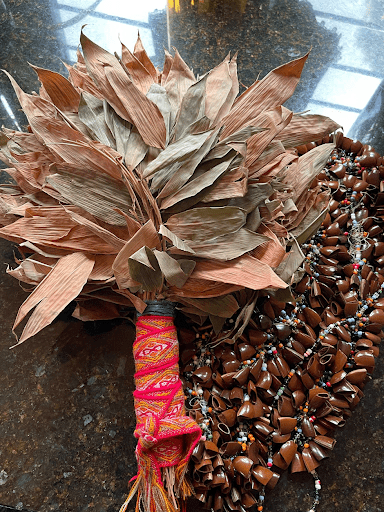
Picture of cascaveles and Wayra
Nature is the oldest musician.
Global Variations of Ayahuasca Ceremony Music
Across the globe, ayahuasca music traditions differ:
- Peru: Strong focus on icaros taught through dieta (apprenticeship with plants).
- Colombia: Emphasis on rezos and harmonica, honoring local cultural roots.
- Brazil: Integration with Christian hymns and group singing in Santo Daime rituals.
- Western retreats: A blend of traditional songs with instruments like crystal bowls and hand pans.
Competitors often showcase global playlists or generic “medicine music collections.” Our differentiator is the emphasis on authenticity and training — music is learned through direct apprenticeship with elders, not curated from Spotify.
Evolving Sounds – Modern Instruments in Ceremonies
As ceremonies evolve, new instruments find their place:
- Hand pans and hand drums
- Crystal harps
- Singing bowls
Some may critique these additions, but soft instruments often help participants ease into states of harmony. Just as guitars once were new, the ceremony continues to grow with life itself.
Live Music vs. Recorded Music
One of the clearest distinctions in authentic Ayahuasca ceremonies is that music is played live.
- Live music carries presence, intention, and a direct energetic connection.
- Recorded tracks, on the other hand, feel flat and disconnected. They are often seen as a red flag that the shaman lacks proper training.
In rare, special cases, recorded sound may be used — but it is the exception, not the rule.
Medicine Music as a New Genre
Over the years, a movement called “medicine music” has emerged. These songs often carry messages of love, Mother Earth, family, and compassion.
- Many are in Spanish, honoring Latin roots.
- More and more are appearing in English, making the medicine accessible to global communities (we also play English songs in our ceremonies).
Here you can find playlist on spotify and Youtube:
For those who feel called to learn, here are two schools dedicated to teaching medicine music:
- Medicine Music School created by my friend Ivaylo from Colibri Garden
Silence as Medicine
As powerful as music is, silence may be even more transformative.
- In silence, there are no distractions.
- Insights rise up naturally.
- There is a pressure that builds — where emotions “cook,” and deep healing occurs.
Many participants find that in silence they become both lost and found again.
The Difference Between Music and the Medicine
A common mistake is to believe it was the music that gave you a breakthrough, when in reality it was the medicine working through the music.
Take the example of Nicolás Losada, one of Colombia’s most well-known medicine musicians who also shares Ayahuasca. Participants in his ceremonies often ask him, “When will you play?” His answer: “Not yet.” Only towards the end does he play, giving the medicine sufficient time to develop without music as well.
In the most traditional ceremonies, music was minimal. Ayahuasca itself is the teacher. It’s important to not forget that.
Icaros and Rezos – The Songs of the Shamans
In different traditions, the shaman’s songs (prayers) have different names and functions:
- Icaros (Peru): Songs sung by shamans to guide, heal, and shift energy.
- Rezos (Colombia): Prayers that activate and harmonize the medicine, distinct from general music.
These are not just songs — they are energetic tools, carrying power and intention.
Benefits of Listening to Ceremony Music After the Retreat
Listening to medicine music after your retreat can:
- Trigger memories of your ceremony.
- Help with integration.
- Bring you back into the healing vibration.
It’s a powerful way to continue working with the medicine once you’ve returned home.
Find out if Ayahuasca is right for you
- Will you be safe physically and emotionally?
- How will you be supported in the ceremony?
- How do the facilitators handle difficult situations?
- How will you be able to process the experience?
- You want change, but will your life be unrecognizable after Ayahuasca?
+ 13 things to consider before drinking Ayahuasca?
Conclusion – Music as Powerful but Not Essential
Music in Ayahuasca ceremonies is transformative, beautiful, and deeply supportive. It can help unlock visions, bring emotional release, and guide the journey.
And yet, paradoxically, music is not essential. The medicine works with or without it. Music is a bridge — one that connects, harmonizes, and guides, but the medicine itself always remains the teacher.
